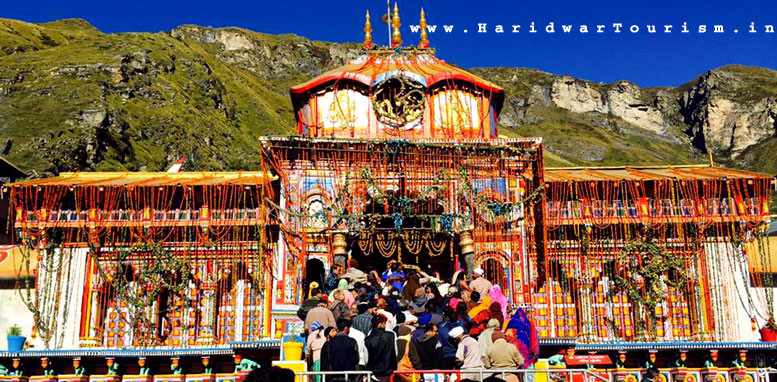|
Badrinath
or Badrinarayan Temple is a Hindu temple dedicated
to Vishnu which is situated in the town of Badrinath in Uttarakhand,
India. The temple and town form one of the four Char Dham
and Chota Char Dham pilgrimage sites. The temple is also one
of the 108 Divya Desams dedicated to Vishnu, who is worshipped
as Badrinath — holy shrines for Vaishnavites. It is open for
six months every year (between the end of April and the beginning
of November), because of extreme weather conditions in the
Himalayan region. The temple is located in Garhwal hill tracks
in Chamoli district along the banks of Alaknanda River at
an elevation of 3,133 m (10,279 ft) above the mean sea level.
Badrinath is one of the most visited pilgrimage
centres of India, having recorded 1,060,000 visits.
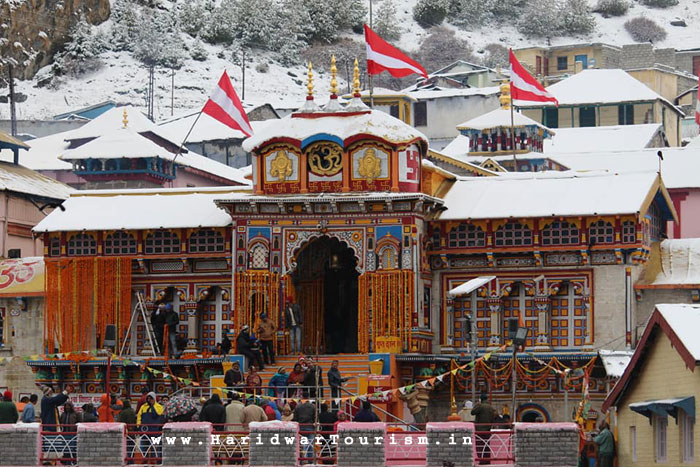
The image of the presiding deity worshipped in the temple
is a 1 m (3.3 ft) tall, black stone statue of Vishnu in the
form of Badrinarayan. The statue is considered by many Hindus
to be one of eight swayam vyakta kshetras, or self-manifested
statues of Vishnu.
Mata Murti Ka Mela, which commemorates the descent of river
Ganges on mother earth, is the most prominent festival celebrated
in the Badrinath Temple. Although Badrinath is located in
North India, the head priest, or Rawal, is traditionally a
Nambudiri Brahmin chosen from the South Indian state of Kerala.
The temple was included in the Uttar Pradesh state government
Act No. 30/1948 as Act no. 16,1939, which later came to be
known as Shri Badarinath and Shri Kedarnath Mandir Act. The
committee nominated by the state government administers both
the temples and has seventeen members on its board.
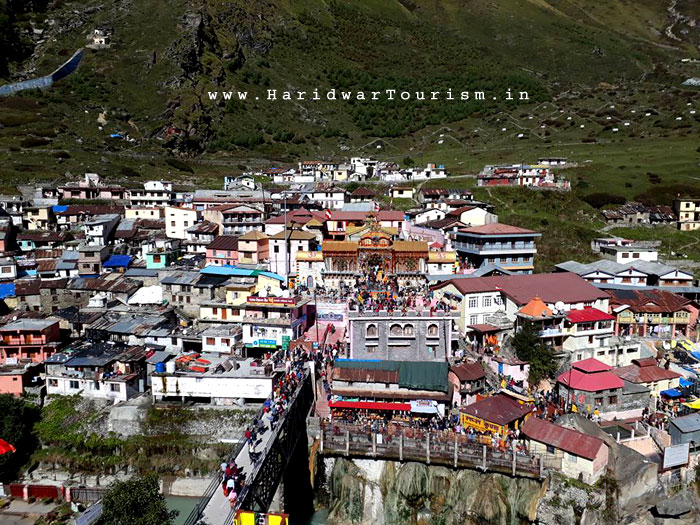
The Badrinath Dham temple is mentioned in ancient religious
texts like Vishnu Purana and Skanda Purana. It is glorified
in the Divya Prabandha, an early medieval Tamil canon of the
Azhwar saints from the 6th–9th centuries AD
Location, Architecture, & Shrines
The Badrinath Dham temple is located in Garhwal hill tracks
along the banks of the Alaknanda River[2] in Chamoli district
in Uttarakhand, a state in North India. The hill tracks are
located 3,133 m (10,279 ft) above the mean sea level. The
Nar Parbat mountain is located opposite to the temple, while
the Narayana Parbat is located behind the Neelakanta peak.
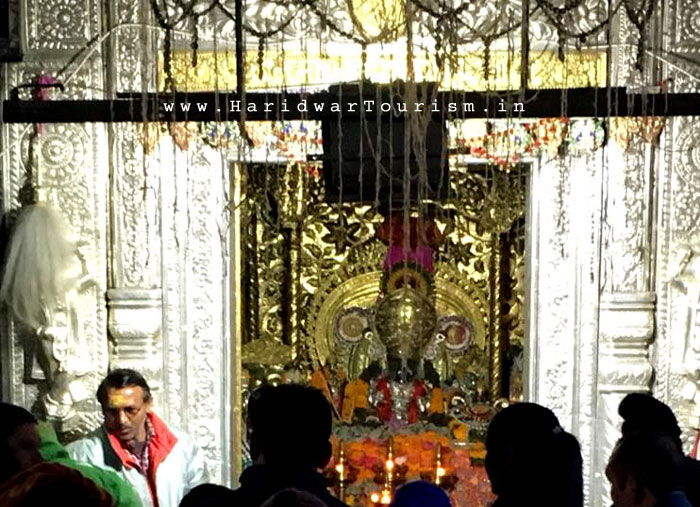
The Badrinath temple has three structures: the Garbhagriha
(sanctum), the Darshan Mandap (worship hall), and Sabha Mandap
(convention hall). The conical-shaped roof of the sanctum,
the garbhagriha, is approximately 15 m (49 ft) tall with a
small cupola on top, covered with a gold gilt roof. The facade
is built of stone and has arched windows. A broad stairway
leads up to the main entrance, a tall, arched gateway. Just
inside is a mandap, a large, pillared hall that leads to the
sanctum, or main shrine area. The walls and pillars of the
hall are covered with intricate carvings.
The main shrine houses the 1 m (3.3 ft) Shaligram (black stone)
image of Badrinarayan, which is housed in a gold canopy under
a Badri Tree. The image of Badrinarayan holds a Shankha (conch)
and a Chakra (wheel) in two of its arms in a lifted posture
and two arms are rested on its lap in a Yogamudra (Padmasana)
posture. The sanctum also houses images of the god of wealth—Kubera,
sage Narada, Uddhava, Nar and Narayan. There are fifteen more
images that are also worshipped around the temple. These include
that of Lakshmi (the consort of Vishnu), Garuda (the vahana
of Narayan), and Navadurga, the manifestation of Durga in
nine different forms. The temple also has shrines of Lakshmi
Narasimhar and for saints Adi Shankara (ad 788-820), Vedanta
Desika and Ramanujacharya. All the idols of the temple are
made of black stone.
The Tapt Kund at Badrinath Dham Mandir, a group of
hot sulphur springs just below the temple, are considered
to be medicinal; many pilgrims consider it a requirement to
bathe in the springs before visiting the temple.
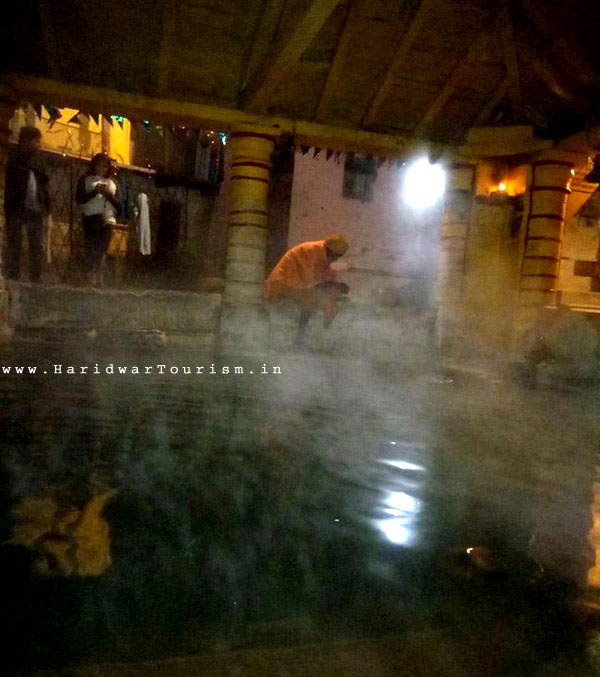
The springs have a year-round temperature of 55 °C (131 °F),
while outside temperature is typically below 17 °C (63 °F)
all year round. The two water ponds in the temple are called
Narad Kund and Surya Kund
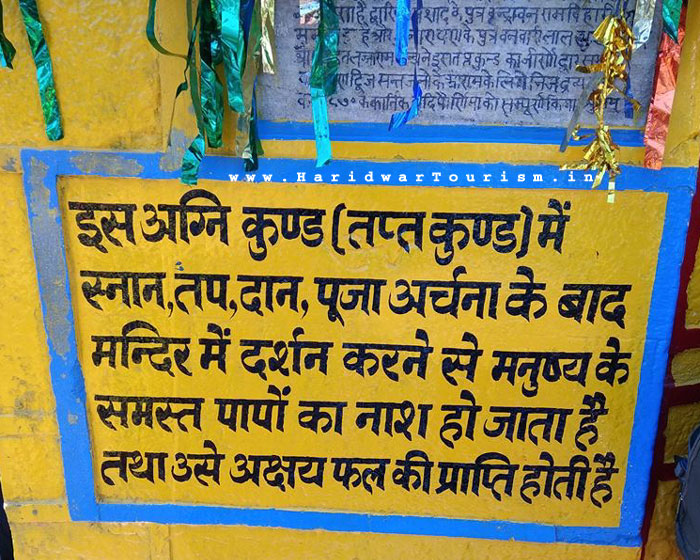
History of Badrinath
It
was originally established as a pilgrimage site by Adi Shankara
in the ninth century. It is believed that Shankara resided
in the place for six years from ad 814 to 820. He resided
six months in Badrinath and the rest of the year in Kedarnath.
Hindu followers assert that he discovered the image of Badrinath
in the Alaknanda River and enshrined it in a cave near the
Tapt Kund hot springs. A traditional story asserts that Shankara
expelled all the Buddhists in the region with the help of
the Parmar ruler king Kanak Pal. The hereditary successors
of the king governed the temple and endowed villages to meet
its expenses. The income from a set of villages on the route
to the temple was used to feed and accommodate pilgrims. The
Parmar rulers held the title "Bolanda Badrinath", meaning
speaking Badrinath. They had other titles, including Shri
108 Basdrishcharyaparayan Garharj Mahimahendra, Dharmabibhab
and Dharamarakshak Sigamani.
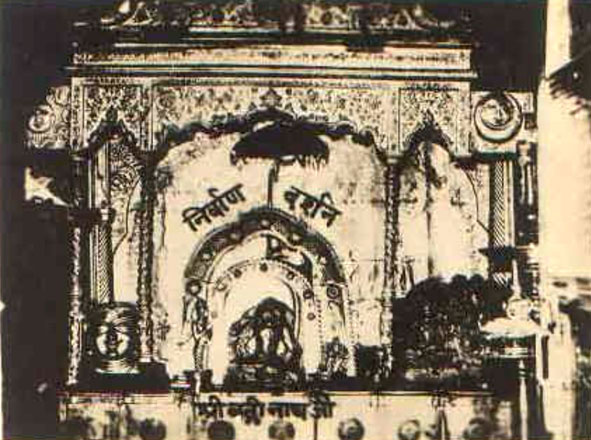
The throne of Badrinath was named after the presiding deity;
the king enjoyed ritual obeisance by the devotees before proceeding
to the shrine. The practice was continued until the late 19th
century. During the 16th century, the King of Garhwal moved
the murti to the present temple. When the state of Garhwal
was divided, the Badrinath temple came under British rule
but the king of Garhwal continued as the chairman of the management
committee.
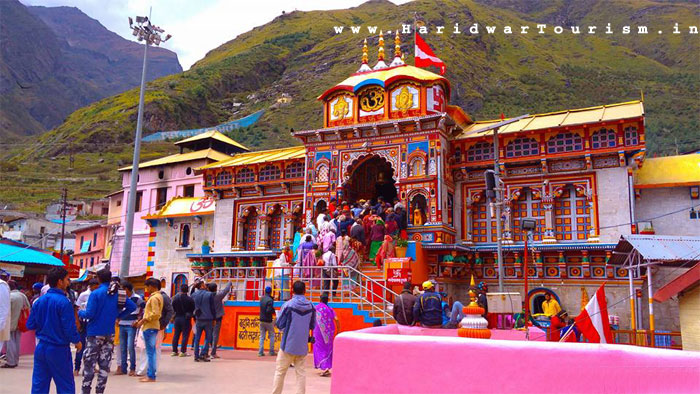
The Badrinath Dham temple has undergone several major renovations
due to its age and damage by an avalanche. In the 17th century,
the temple was expanded by the Kings of Garhwal. After significant
damage in the great 1803 Himalayan earthquake, it was largely
rebuilt by the King of Jaipur. It was still under renovation
as late as the 1870s but these were completed by the time
of the First World War. At that time, the town was still small,
consisting of only the 20-odd huts housing the temple's staff,
but the number of pilgrims was usually between seven and ten
thousand. The Kumbh Meld festival held every twelve years
raised the number of visitors to 50,000. The temple also enjoyed
revenue from the rents owed to it by various villages bequeathed
by various rajas.
During 2006, the state government announced the area around
Badrinath as a no construction zone to curb illegal encroachment.
Timings for Badrinath Dham Prayers
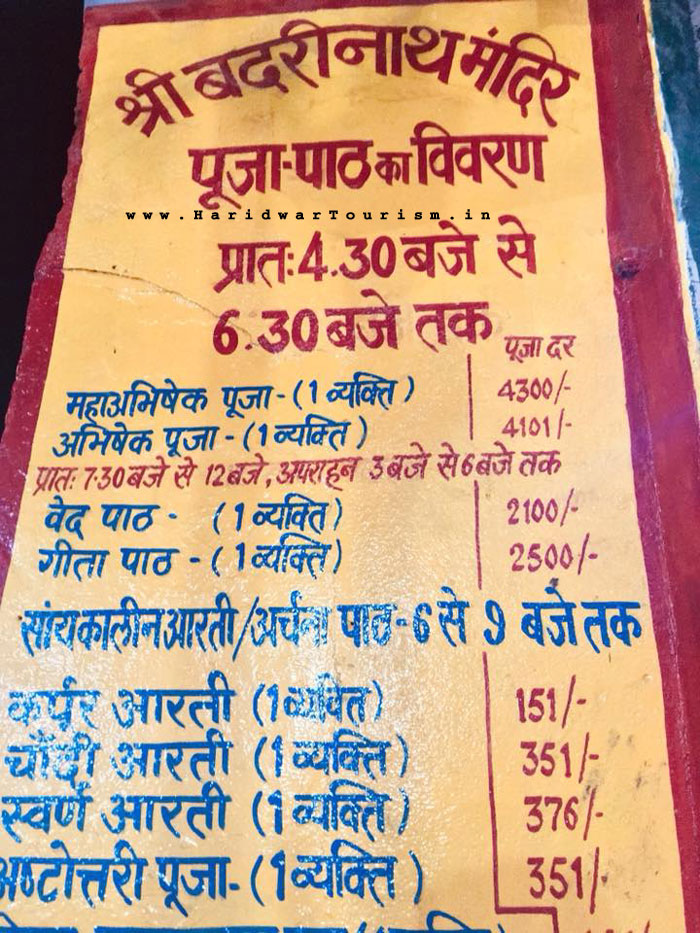
Legend
According to Hindu legend, god Vishnu sat in meditation
at this place, keeping away from Thuling, a place in the Himalayas
which was corrupted by meat-eating monks and unchaste people.
During his meditation, Vishnu was unaware of cold weather.
Lakshmi, his consort, protected him in the form of the Badri
tree (jujube or Indian date). Pleased by the devotion of Lakshmi,
Vishnu named the place Badrika Ashram. According to Atkinson
(1979), the place used to be a jujube forest, which are not
found there today. Vishnu in the form of Badrinath is depicted
in the temple sitting in the padmasana posture. According
to the legend, Vishnu was chastised by a sage, who saw Vishnu's
consort Lakshmi massaging his feet. Vishnu went to Badrinath
to perform austerity, meditating for a long time in padmasana.

The Vishnu Purana narrates another version of the origins
of Badrinath. According to the tradition, Dharam had two sons,
Nar and Narayan—both of which are modern names of Himalayan
mountains. They chose the place to spread their religion and
each of them wed the spacious valleys in the Himalayas. Searching
for an ideal place to set up a hermitage, they came across
the other four Badris of the Pancha Badri, namely Bridha Badri,
Yog Bhadri, Dhyan Badri and Bhavish Badri. They finally found
the hot and cold spring behind the Alaknanda River and named
it Badri Vishal.
Literary Mention
The temple finds mention in several ancient books like
Bhagavata Purana, Skanda Purana and Mahabharata. According
to the Bhagavata Purana, there in Badrikashram the Personality
of Godhead (Vishnu), in his incarnation as the sages Nar and
Narayana, had been undergoing great penance since time immemorial
for the welfare of all living entities". The Skanda Purana
states that there are several sacred shrines in heaven, on
earth, and in hell; but there is no shrine like Badrinath".
The area around Badrinath is also celebrated in Padma Purana
as abounding in spiritual treasures. The Mahabharata revered
the holy place as the one which can give salvation to devotees
arriving close to if, while in other holy places they must
perform religious ceremonies. The temple is revered in Nalayira
Divya Prabandham, in 11 hymns in the 7th – 9th century Vaishnava
canon by Periazhwar and in 13 hymns in Thirumangai Azhwar.
It is one of the 108 Divyadesam dedicated to Vishnu, who is
worshipped as Badrinath.
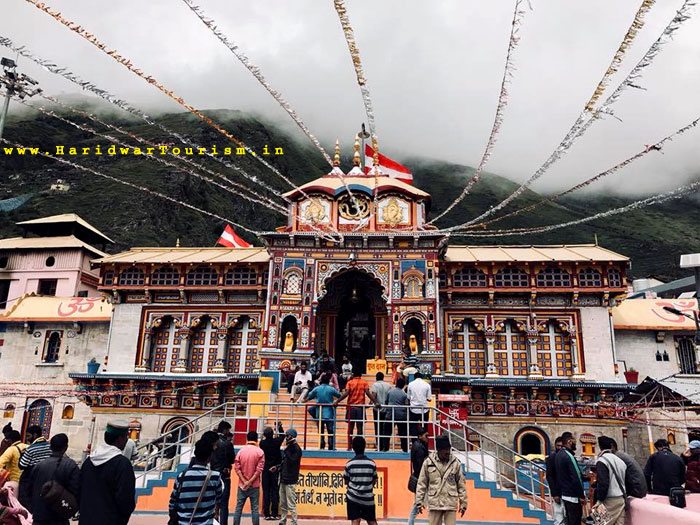
Pilgrimage
The Badrinath temple is one of five related shrines called
Panch Badri, which are dedicated to the worship of Vishnu.
The five temples are Vishal Badri - Badrinath Temple in Badrinath,
Yogadhyan Badri located at Pandukeshwar, Bhavishya Badri located
17 km (10.6 mi) from Jyotirmath at Subain, Vridh Badri located
7 km (4.3 mi) from Jyotirmath in Animath and Adi Badri located
17 km (10.6 mi) from Karnaprayag. The temple is considered
one of the holiest Hindu Char Dham (four divine) sites, comprising
Rameswaram, Badrinath, Puri and Dwarka. Although the temple's
origins are not clearly known, the Advaita school of Hinduism
established by Adi Shankara attributes the origin of Char
Dham to the seer. The four monasteries are located across
the four corners of India and their attendant temples are
Badrinath Temple at Badrinath in the North, Jagannath Temple
at Puri in the East, Dwarakadheesh Temple at Dwarka in the
West and Sri Sharada Peetam Sringeri at Sringeri,Karnataka
in the South.

Though ideologically the temples are divided between the sects
of Hinduism, namely Saivism and Vaishnavism, the Char Dham
pilgrimage is an all-Hindu affair. There are four abodes in
the Himalayas called Chota Char Dham (Chota meaning small):
Badrinath, Kedarnath, Gangotri and Yamunotri—all of which
lie in the foothills of the Himalayas. The name Chota was
added during the mid of 20th century to differentiate the
original Char Dhams. As the number of pilgrims to these places
has increased in modern times, it is called Himalayan Char
Dham.
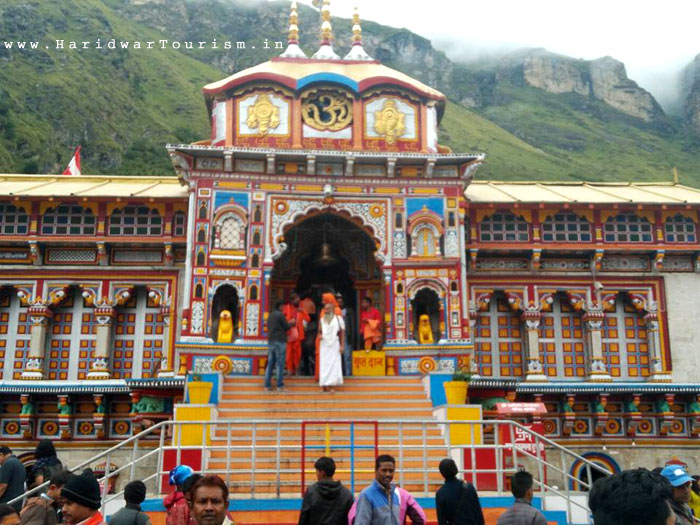
The journey across the four cardinal points in India is considered
sacred by Hindus, who aspire to visit these temples once in
their lifetimes. Traditionally, the pilgrimage starts at the
eastern end from Puri, proceeding clockwise in a manner typically
followed for circumambulation in Hindu temples.
Festivals and religious practices
The most prominent festival held at Badrinath Temple is Mata
Murti Ka Mela, which commemorates the descent of the river
Ganges on mother earth. The mother of Badrinath, who is believed
to have divided the river into twelve channels for the welfare
of earthly beings, is worshiped during the festival. The place
where the river flowed became the holy land of Badrinath.
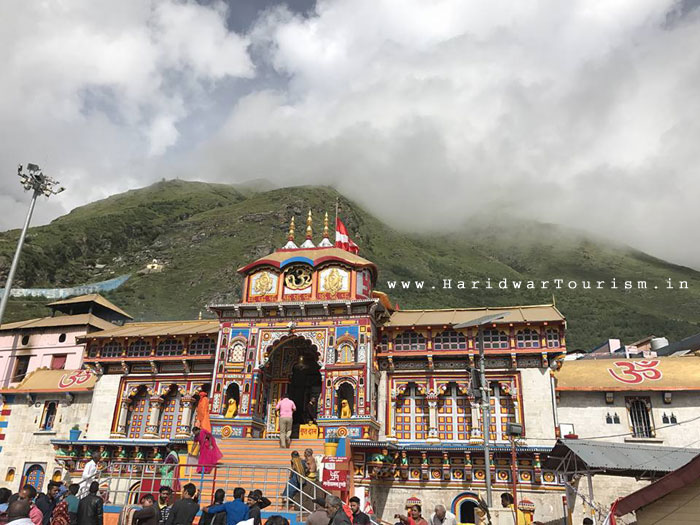
The Badri Kedar festival is celebrated during the month of
June in both the temple and the Kedarnath temple. The festival
lasts for eight days; artists from all over the country perform
during the function.
The major religious activities (or pujas) performed every
morning are mahabhishek (ablution), abhishek, gitapath and
bhagavat puja, while in the evening the pujas include geet
govinda and aarti. Recital in vedic scripts like Ashtotram
and Sahasranama is practiced during all the rituals. After
aarti, the decorations are removed from the image of Badrinath
and sandalwood paste is applied to it. The paste from the
image is given to the devotees the next day as prasad during
the nirmalaya darshan. All the rituals are performed in front
of the devotees, unlike those in some Hindu temples, where
some practices are hidden from them. Sugar balls and dry leaves
are the common prasad provided to the devotees. From May 2006,
the practise of offering Panchamrit Prasad, prepared locally
and packed in local bamboo baskets, was started.

The Badrinath Dham temple is closed for winter on the auspicious
day of bhatridwityia or later during October–November. On
the day of closure, Akhanda Jyothi, a lamp is lit filled with
ghee to last for six months. Special pujas are performed on
the day by the chief priest in the presence of pilgrims and
officials of the temple. The image of Badrinath is notionally
transferred during the period to the Narasimha temple at Jyotirmath,
located 40 mi (64 km) away from the temple. The temple is
reopened around April-May on Akshaya tritiya, another auspicious
day on the Hindu calendar. Pilgrims gather on the first day
of opening of the temple after the winter to witness the Akhanda
Jyothi.

The Badrinath Dham temple is one of the holy places where
the Hindus offer oblations to ancestors with the help of the
priests. Devotees visit the temple to worship in front of
the image of Badrinath in the sanctum and have a hold dip
in Alaknanda River. The general belief is that a dip in the
tank purifies the soul.
|
